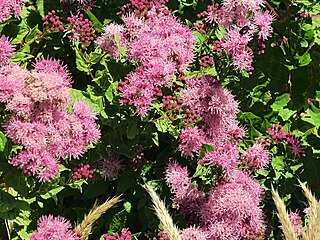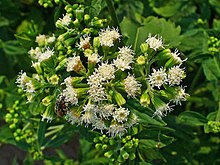
Eupatorium is a genus of flowering plants in the family Asteraceae, containing from 36 to 60 species depending on the classification system. Most are herbaceous perennials growing to 0.5–3 m (1.6–9.8 ft) tall. A few are shrubs. The genus is native to temperate regions of the Northern Hemisphere. Most are commonly called bonesets, thoroughworts or snakeroots in North America. The genus is named for Mithridates Eupator, king of Pontus.

Rudbeckia laciniata, the cutleaf coneflower, is a species of flowering plant in the family Asteraceae. It is native to North America, where it is widespread in both Canada and the United States. Its natural habitat is wet sites in flood plains, along stream banks, and in moist forests. Common names other than cutleaf coneflower include cutleaf, goldenglow, green-headed coneflower, tall coneflower, sochan and thimbleweed.
White snakeroot is a common name for several flowering plants in the aster family, Asteraceae, and may refer to:

Ageratina shastensis is a species of snakeroot which is endemic to Shasta County, California. It is known by the common names Mt. Shasta snakeroot and Shasta eupatorium.

Eupatorium altissimum, with the common names tall thoroughwort and tall boneset, is a perennial herbaceous plant in the Asteraceae family with a native range including much of the eastern and central United States and Canada. It is a tall plant found in open woods, prairies, fields, and waste areas, with white flowers that bloom in the late summer and fall.

Eutrochium maculatum, the spotted joe-pyeweed, is a North American species of flowering plant in the family Asteraceae. It is widespread through much of the United States and Canada. It is the only species of the genus Eutrochium found west of the Great Plains.

Ageratina riparia, commonly known as mistflower, is a species of flowering plant in the family Asteraceae, native to Mexico. The species is widely adventive and has spread to Cuba, Jamaica, and other parts of the Caribbean. It has also been introduced as an ornamental plant and naturalized in a variety of regions, including parts of Hawaii, South Africa, Southeast Asia, Macaronesia, Oceania, Peru, and the Indian subcontinent. In tropical climates, A. riparia is highly invasive and a variety of control methods have been developed to reduce its spread.

Ageratina herbacea is a North American species of flowering plants in the family Asteraceae known by the common names fragrant snakeroot and Apache snakeroot. It is native to desert regions of the southwestern United States and northern Mexico. It grows in rocky slopes in conifer forests and woodlands.

Ageratina occidentalis is a species of flowering plant in the family Asteraceae known by the common name western snakeroot or western eupatorium. It is native to the western United States where it grows in several types of habitat. It is found in California, Oregon, Washington, Idaho, Montana, Nevada, and Utah.

Ageratina adenophora, commonly known as Crofton weed, is a species of flowering plant in the family Asteraceae native to Mexico and Central America. Originally grown as an ornamental plant, it has become invasive into farmland and bushland worldwide. It is toxic to horses, which develop a respiratory disease known as Numinbah horse sickness after eating it.

Veratrum hybridum is a species of flowering plant in the Melanthiaceae known by the common names slender bunchflower and crisped bunchflower. Many publications use the synonyms Melanthium latifolium and Veratrum latifolium, but the "hybridum" epithet is 9 years older than the "latifolium," so Veratrum hybridum is now the accepted name.

Ageratina luciae-brauniae is a species of flowering plant in the family Asteraceae known by the common names Lucy Braun's snakeroot and rockhouse white snakeroot. It is native to the eastern United States, where it is limited to the Cumberland Plateau of Kentucky and Tennessee. It may also occur in South Carolina but these reports are unconfirmed.

Anna Pierce Hobbs Bixby, sometimes spelled Bigsby, born Anna Pierce, was a midwife, frontier doctor, dentist, herbologist, and scientist in southern Illinois.

Orbexilum pedunculatum, commonly known as Sampson's snakeroot, is a species of flowering plant in the legume family. It is native primarily to the Southeastern United States where it is found in prairies and savannas, often in acidic soil. It is a perennial that produces racemes of flowers in early summer.

Tremetone is a constituent of the toxic compound tremetol, found in snakeroot, that causes milk sickness in humans and trembles in livestock. Tremetone is the main constituent of at least 11 chemically related substances in tremetol. Tremetone is toxic to fish, but not to chicken, and is therefore not the major toxic compound in tremetol. Tremetol can be found in a number of different species of the family Asteraceae, including snakeroot and rayless goldenrod.

Ageratina aromatica, also known as lesser snakeroot and small-leaved white snakeroot, is a North American species of plants in the family Asteraceae. It is widespread and common across much of the eastern and southern United States from Louisiana to Massachusetts, as far inland as Kentucky and Ohio.
Ageratina jucunda, called the Hammock snakeroot, is a North American species of plants in the family Asteraceae. It is found only in the southeastern United States, in the states of Georgia and Florida. It is a perennial herb growing up to 3 ft (0.91 m) tall.
Ageratina paupercula, called the Santa Rita snakeroot, is a North American species of shrubs or perennial herbs in the family Asteraceae. It is found only in the states of Arizona, Sonora, Chihuahua, Durango, Nayarit, and Jalisco.
Ageratina rothrockii is a North American species of plants in the family Asteraceae. It is found only in the southwestern United States in the states of Arizona, New Mexico, and Texas, as well as the states of Sonora, Coahuila, Chihuahua, and Durango in Mexico.
Ageratina wrightii is a North American species of plants in the family Asteraceae. It is native to the southwestern United States and northern Mexico.



















